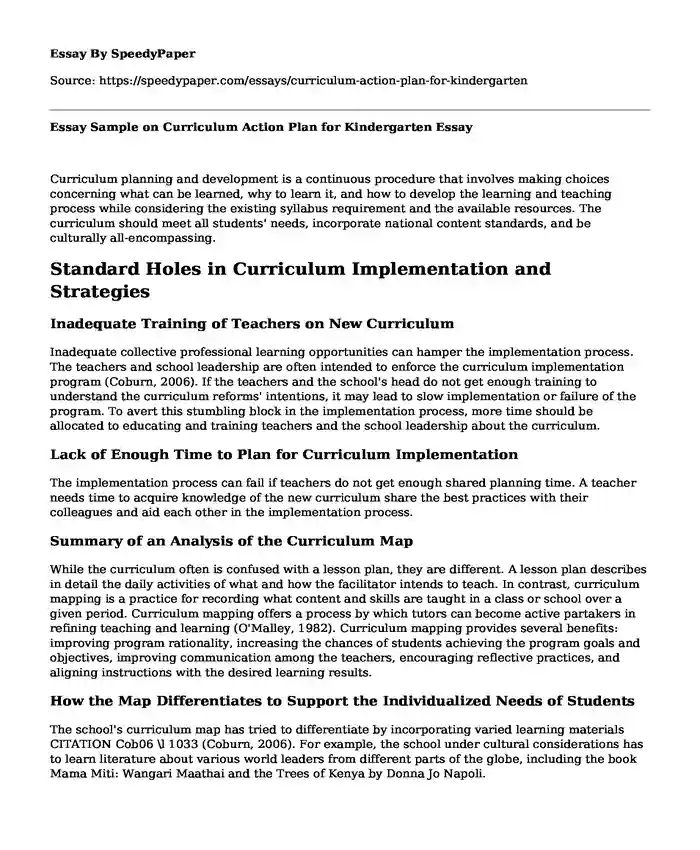
| Essay type: | Process essays |
| Categories: | Teaching Planning Learning |
| Pages: | 4 |
| Wordcount: | 854 words |
Curriculum planning and development is a continuous procedure that involves making choices concerning what can be learned, why to learn it, and how to develop the learning and teaching process while considering the existing syllabus requirement and the available resources. The curriculum should meet all students' needs, incorporate national content standards, and be culturally all-encompassing.
Standard Holes in Curriculum Implementation and Strategies
Inadequate Training of Teachers on New Curriculum
Inadequate collective professional learning opportunities can hamper the implementation process. The teachers and school leadership are often intended to enforce the curriculum implementation program (Coburn, 2006). If the teachers and the school's head do not get enough training to understand the curriculum reforms' intentions, it may lead to slow implementation or failure of the program. To avert this stumbling block in the implementation process, more time should be allocated to educating and training teachers and the school leadership about the curriculum.
Lack of Enough Time to Plan for Curriculum Implementation
The implementation process can fail if teachers do not get enough shared planning time. A teacher needs time to acquire knowledge of the new curriculum share the best practices with their colleagues and aid each other in the implementation process.
Summary of an Analysis of the Curriculum Map
While the curriculum often is confused with a lesson plan, they are different. A lesson plan describes in detail the daily activities of what and how the facilitator intends to teach. In contrast, curriculum mapping is a practice for recording what content and skills are taught in a class or school over a given period. Curriculum mapping offers a process by which tutors can become active partakers in refining teaching and learning (O'Malley, 1982). Curriculum mapping provides several benefits: improving program rationality, increasing the chances of students achieving the program goals and objectives, improving communication among the teachers, encouraging reflective practices, and aligning instructions with the desired learning results.
How the Map Differentiates to Support the Individualized Needs of Students
The school's curriculum map has tried to differentiate by incorporating varied learning materials CITATION Cob06 \l 1033 (Coburn, 2006). For example, the school under cultural considerations has to learn literature about various world leaders from different parts of the globe, including the book Mama Miti: Wangari Maathai and the Trees of Kenya by Donna Jo Napoli.
Which Instructional Resources that Support the Curriculum
The curriculum map incorporates the use of educational toys. Research has proven that learning through play is an essential part of any child's growth (Gardner, 1993). Educational toys help develop the child's problem-solving skills, conflict management, sharing, creativity, and imagination.
The school employs learner-centered teaching using inductive techniques such as analysis-based learning, situation-based learning, problem-solving learning, discovery education, and event-time schooling (Dyjur, Grant, & Kalu, 2019). For example, in unit 2 module 1, the students on the title of speaking and listening to inquiry-based learning are practices as the learners discover their classmate's favorite toys by interviewing them.
The school focuses on assigning meaningful reading and writing tasks rather than the traditional way of emphasizing drill and practice. Assigning significant tasks helps the students in incorporating new knowledge and old knowledge.
How the Map Reflects the School's Vision and Mission
The school's module instructions and Workrooms work collectively to help students acquire literacy skills as they gain knowledge about the globe. The curriculum map has reflected the school's vision and mission in various ways. On developing literacy skills, the curriculum map, through its multiple units, has incorporated learning activities such as enhancing speaking and listening to the school. It includes activities such as a discussion on oral presentation and drawing and dictation. On building knowledge about the world, the curriculum map has incorporated books from around the globe, including Mama Miti: Wangari Maathai and the Trees of Kenya by Donna Jo Napoli.
An Area that Needs Refinement
Children are different according to their reception to learning instructions such as reading and writing. Hence the total time available for literacy learning is essential. The school needs to develop its instruction process so that slow learners are enabled access to a more advanced level literacy instruction.
Recommendation to the school
The school should consider its stand on the cultural appropriateness of instructions. Cultural suitability involves taking into consideration the materials and kind of activities carried out in the school. Students from different cultures such as African-American, Latino, or Asian-Americans, require a wide range of multicultural literature. The inclusion of multicultural literature in the reading curriculum can empower learners through the reading of their cultures. Learners learn best when the curriculum reflects their daily experiences, learning, and viewpoints.
References
Coburn, E. C. (2006). Framing the Problem of Reading Instruction: Using Frame Analysis to Uncover the Microprocesses of Policy Implementation. American Educational Research Journal, 43(3), 343-349.
Corno, L. (2008). On teaching adaptatively. Educational Psychologist, 43(3), 161-173.
Dyjur, P., Grant, K., & Kalu, F. (2019). Curriculum Review: Analyzing curriculum mapping data. Calgary: Taylor Institute for Teaching and Learning.
Gardner, H. (1993). The theory of multiple intelligence: Design and implementation. New York: Basic Books.
O'Malley, J. P. (1982, August). Learn the truth about the curriculum. The Executive Educator, 4, 14-26.
Cite this page
Essay Sample on Curriculum Action Plan for Kindergarten. (2023, Oct 26). Retrieved from https://speedypaper.net/essays/curriculum-action-plan-for-kindergarten
Request Removal
If you are the original author of this essay and no longer wish to have it published on the SpeedyPaper website, please click below to request its removal:
- Paraphrasing Essay Sample
- Program Essay Example on the Design Entrepreneurship Course
- Learn More about Hospitality Service Experiences from Our Essay Example
- Free Essay: Why Online Learning is Effective
- Essay Sample on How Great Leaders Inspire Action
- Building Construction and Hazards for Firefighters. Free Essay
- Exploring the Impact and Evaluation of the 4Rs Program - Essay Sample
Popular categories




